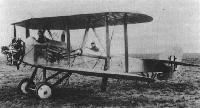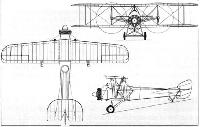Фотографии
-
The C.205N/1 and the C.205N/2 (shown) differed one from the other primarily in the arrangement of the armament.
Самолёты на фотографии: Macchi MC.205 Veltro - Италия - 1942
-
The C.205N/1 (shown) and the C.205N/2 differed one from the other primarily in the arrangement of the armament.
Самолёты на фотографии: Macchi MC.205 Veltro - Италия - 1942
-
MANN AND GRIMMER M.1. The curious biplane known as the Mann and Grimmer M.1 was produced with the object of incorporating the advantages of the "pusher" without the need for tail-booms, and the two propellers were driven by a shaft and chain transmission from the single 100-h.p. (later 125-h.p.) Anzani engine in the nose. It was designed by R. F. Mann and R. P. Grimmer and first flew at Hendon on 19th February 1915, piloted by Mr. Rowland Ding. It was intended as a home-defence fighter. A modified version known as the M.2 was planned, and the firm secured a Government order for an M.2a, but it was not completed and they closed down in 1916. The M.1 was credited with a speed of 85 m.p.h.
Самолёты на фотографии: Mann & Grimmer M.1 - Великобритания - 1915
-
The Mann & Grimmer M.1 in its definitive form.
Самолёты на фотографии: Mann & Grimmer M.1 - Великобритания - 1915
-
The first prototype Mann Egerton Type H (serial N44) with flush-fitting floats
Самолёты на фотографии: Mann & Egerton H - Великобритания - 1917
-
The second prototype (serial N45) which featured a more conventional undercarriage.
Самолёты на фотографии: Mann & Egerton H - Великобритания - 1917
-
The second prototype which featured a more conventional undercarriage.
Самолёты на фотографии: Mann & Egerton H - Великобритания - 1917
-
The Marchetti MVT, alias S.50, after re-engining with a 285 hp SPA 62a as entered in the fighter contest of 1923.
Самолёты на фотографии: Marchetti-Vickers-Terni MVT - Италия - 1919
-
The Marchetti MVT, alias S.50, after re-engining with a 285 hp SPA 62a as entered in the fighter contest of 1923.
Самолёты на фотографии: Marchetti-Vickers-Terni MVT - Италия - 1919
-
The Gabardini G.9 as originally flown with a six-cylinder SPA 6a engine, this fighter having been evolved in parallel with the G.8.
Самолёты на фотографии: Gabardini G.8 / G.9 - Италия - 1924
-
The G.9 was subsequently re-engined and fitted with a deeper cabane as the G.9bis as illustrated.
Самолёты на фотографии: Gabardini G.8 / G.9 - Италия - 1924
-
The G.9 was subsequently re-engined and fitted with a deeper cabane as the G.9bis as illustrated.
Самолёты на фотографии: Gabardini G.8 / G.9 - Италия - 1924
-
Самолёты на фотографии: Mark (Markische) D.I - Германия - 1918
-
The original Heinrich Pursuit with 100 hp Gnome engine that powered the first two prototypes. The third and fourth aircraft featured a revised cabane and a lower-powered engine.
Самолёты на фотографии: Heinrich Pursuit - США - 1917
-
Самолёты на фотографии: Heinrich Pursuit - США - 1917
-
The Hereter T.H. designed by Heraclio Alfaro for the 1919 Concurso de Aviones
Самолёты на фотографии: Alfaro 8 - Испания - 1919
-
The IVL C.24 after the application of slight sweepback to the wings.
Самолёты на фотографии: IVL C.24 / C.25 - Финляндия - 1924
-
The IVL C.25 which underwent six months testing in 1925 prior to its destruction in a crash
Самолёты на фотографии: IVL C.24 / C.25 - Финляндия - 1924
-
The IVL C.25 which underwent six months testing in 1925 prior to its destruction in a crash.
Самолёты на фотографии: IVL C.24 / C.25 - Финляндия - 1924
-
The Kjeller FF 6 was originally designed as a single-seat fighter, but was completed as a two-seat fighter-reconnaissance aircraft.
Самолёты на фотографии: Kjeller FF.6 - Норвегия - 1921
Статьи
- -
- Airdata File
- Colour Contrasts at Stans
- Fighter A to Z
- Model enthusiast
- ??? - Liore-Et-Olivier 45 ... A Study in Elegance /Warbirds/
- ??? - Orlik ... A Polish Fledgeling
- ??? - Watsonville Comes of Age /Veteran & Vintage/
- D.Brown - Home of the Right Stuff
- M.Hirst - Propeller Power (5)
- P.Jackson - Tornado Comes on Fighting



















